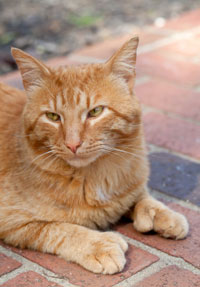Polydactyly: Why Some Cats Have Extra Toes
 Ernest Hemingway made his home on a small island off Key West, Florida. With him lived a colony of about 50 cats. Roughly half of those cats had extra toes instead of the usual 5 toes per front foot and 4 toes per back foot.
Ernest Hemingway made his home on a small island off Key West, Florida. With him lived a colony of about 50 cats. Roughly half of those cats had extra toes instead of the usual 5 toes per front foot and 4 toes per back foot.
This feature was considered lucky by sailors, who thought the extra toes lent better sea legs to the kitties as well as better mouse-catching abilities. This may explain why extra-toed kitties are more common in the eastern United States, having been brought over from England in colonial times. A sailor may have given such a cat to Hemingway as a gift, and that cat then spread the gene for extra toes through further generations. Today, you can visit Hemingway’s island home and see the cat colony still in existence.
"Hemingway cats" are also known as "mitten cats," "thumb cats," and "Boston thumb cats"—but most of all they are known as "polydactyls." The trait that binds them together is technically called polydactyly, which is Greek for "many fingers." Polydactyly has been reported in many kinds of animals, including dogs, mice, horses, and humans. The genetic basis of this condition is not yet understood.
"Dominant" inheritance means that if a kitten has a single copy of the gene for polydactyly (either from the mother or the father) he will have extra toes. Based on clinical observations, the inheritance is thought to probably be "incomplete," or about 50% chance of showing the trait. This would explain why about half of Hemingway's colony have extra toes, because after so many years of inbreeding presumably they now all carry the gene.
Polydactyls may range from having one extra claw to several extra toes, to even an extra foot! It is most common to have extra toes on the front feet, but they can be on the back feet as well. There are several 28-toed kitties currently reported to be padding about, but the largest ever verified number of toes was 32, 8 per foot, reported in 1974 on a male cat named “Mickey Mouse” from California.
Up to 40% of Maine Coon cats used to have this trait, but it was bred out of them a number of years ago. Some breeders are trying to reinstate this condition in Maine Coons, and several new breeds are being developed to specifically have this trait.
Potential Problems with Polydactyly
For the most part, polydactyly is simply an endearing characteristic. It is considered an anomaly, not a deformity, in cats, and some people feel the extra “thumbs” are actually opposable, helping their cats to grip their toys. However, there are certain potential issues that may develop with this condition, so toes should be monitored. For this reason, there are ethical questions about intentionally propogating a trait which is rare in nature and may lead to complications without human intervention.
Extra claws are usually situated between and beneath the normal toes, which means the claws are unable to be normally sharpened. This leads to a higher chance of the claws growing into the paw pad and becoming infected. Sometimes the claw can be growing in an outward position, which can lead to snagging and infections. For these reasons, it is critical that the claws be clipped on a regular basis. (If you outfit your polydactyl cat with Soft Paws vinyl nail caps that fit over your cat's clipped claws, you may want to order two different sizes to accommodate your kitty's diverse claws. When ordering Soft Paws, please note if your cat is polydactyl.)
If the extra claw is causing repeated problems, it can be surgically removed by your veterinarian. [Note: We strongly do not advocate claw removal ("declawing") except in cases where it is medically necessary as a response to a health problem. Please see www.declawing.com for more information on declawing and alternatives.]
You May Also Like These Articles:
Why Do Some Cats Have Two Different Colored Eyes?
Cat Kneading: Why Do Cats Do It and What Do People Call It?
Why Do Cats Purr? The How & Why of Cat Purring
Why Do Cats Knock Things Over?




